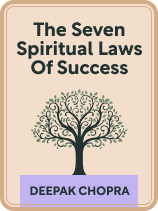

This article is an excerpt from the Shortform book guide to "The Seven Spiritual Laws of Success" by Deepak Chopra. Shortform has the world's best summaries and analyses of books you should be reading.
Like this article? Sign up for a free trial here .
How can alignment with the universe lead to your success? How is this alignment achieved?
Deepak Chopra believes that personal alignment with the flow of thought-energy in the universe is the path to success. He offers five methods of alignment, including meditation and choosing meaningful goals.
Read on for details on all five ways to align with the universe.
How to Align With the Universe
Chopra claims that you can align with the universe—the flow of thought-energy—and experience success in all areas of your life by practicing five interrelated methods.
Method #1: Silence Your Internal Monologue
Chopra argues that practicing silent meditation restricts your internal monologue and allows the thought-energy to flow freely through you. He explains that most of your thoughts focus on analyzing, judging, and classifying your experiences. These thoughts cloud your experiences with thoughts of how you think things should be and prevent you from experiencing the flow of energy in the moment. (Shortform note: Research confirms that practicing stillness through meditation or other mindfulness techniques calms your internal monologue, reduces common symptoms of overthinking such as stress and anxiety, and encourages mental well-being. In Mindfulness in Plain English, Bhante Gunaratana recommends making time for daily mindfulness practice, either in the morning or the evening, and meditating for at least 20 to 20 minutes.)
Method #2: Recognize How Your Reality Reflects Your Thought-Energy
According to Chopra, your thoughts and feelings are always contributing to the mix of thought-energy that makes up your reality—even when you’re not aware of it. Let’s explore how your thoughts impact your thought-energy and experiences in more detail.
Your Experiences Reflect Where and Why You Direct Your Thought-Energy
Chopra explains that all matter in the universe is made up of two things: thought-energy and the information carried within this energy. He argues that thought-energy and the information carried within this energy also define each of your experiences. However, your thoughts directly influence the nature of this information—specifically, your motivation for thinking a thought defines the information within your thought-energy and creates experiences that reflect this motivation.
What you give your attention to directs your thought-energy to specific areas in your life. Further, your intentions for thinking about something define the information within your thought-energy and create life experiences that reinforce those intentions.
You Can Consciously Influence Your Thought-Energy to Create What You Want
Chopra argues that since everything you have and experience is just a reflection of your thought-energy, you can transform your experiences by paying attention to what you think and why you think about it. If you don’t have what you want, consider how the content of your thought-energy prevents you from experiencing these things.
Method #3: Trust and Accept That Every Moment Is as It Should Be
According to Chopra, every moment that occurs is as it should be. Your experiences are neither good nor bad; as noted, they’re simply a reflection of your thought-energy. However, unawareness of this fact leads you to misperceive and resist certain experiences. When you resist your experiences, you also resist your connection to the flow of thought-energy and deny your role in creating your experiences.
To calm your resistant thoughts and take control of your thought-energy, Chopra suggests that you focus on learning. He suggests that you ask yourself what your role is in each of your experiences and consider how to align your thought-energy with what you want to experience.
Method #4: Contribute Positively to the Flow and Exchange of Thought-Energy
According to Chopra, each time you choose to respond to your experiences and other people with a positive attitude, looking to benefit yourself and others, you align yourself with the positive flow of thought-energy and dramatically improve your experiences. Specifically, you direct your thought-energy to flow to and create the experiences that you want. He explains that your intention to benefit others naturally curbs your resistant thoughts—instead of seeing situations as problems and focusing on what you don’t want, you see them as opportunities to seek solutions and focus on what you (and others) do want.
Method #5: Choose Goals That Feel Meaningful to You
Chopra argues that you have innate gifts and talents that you’re meant to contribute to the world and that you should choose goals that align with these natural tendencies because they feel more meaningful and enjoyable to pursue. He claims that aligning your strengths, interests, and positive intentions in this way creates the perfect environment for success.
Chopra notes that directing your natural talents and positive intentions toward goals you enjoy increases your engagement, keeps you focused on what you want to experience, discourages resistant thoughts, and creates an easy and natural momentum.

———End of Preview———
Like what you just read? Read the rest of the world's best book summary and analysis of Deepak Chopra's "The Seven Spiritual Laws of Success" at Shortform .
Here's what you'll find in our full The Seven Spiritual Laws of Success summary :
- Why success isn't based on how much you achieve or accumulate
- How true success comes from aligning with the flow of spiritual energy
- Chopra's five methods for connecting with thought-energy






